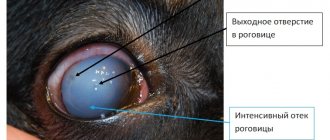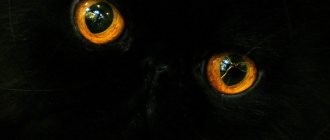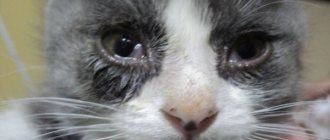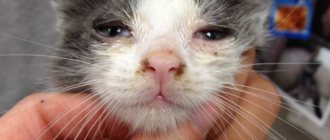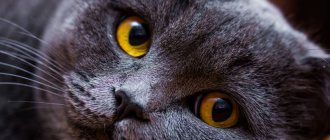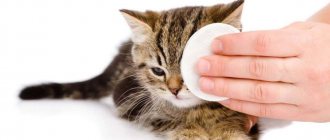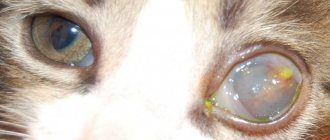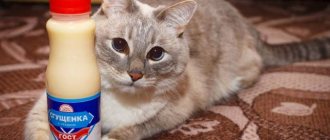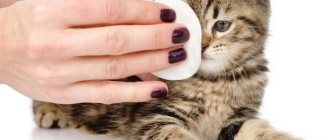03/06/2019 Drozd Nikolaevich Animals
Sometimes small and adult pets experience eye problems. For example, a cat develops excessive lacrimation, the eyelids stick together and turn slightly red, and purulent discharge begins. The animal often covers its eyes from the light with its paw.
The reasons for this condition are different: trauma, breed characteristics, foreign objects, infection, virus, helminths, allergic reaction, age, entropion. Even a common cold or the consequences of a draft provoke the disease. But not everyone knows how to wash a cat’s eyes at home.
Peculiarities
Before starting treatment, it is necessary to consult a veterinarian - a person with medical education and experience will be able to correctly determine the cause of the animal’s illness. After all, even the presence of a foreign object in the eye can sometimes be detected only with the help of special equipment.
You should not wash your cat's eyes for preventive purposes. This is harmful to the cat's health. Without visible signs of illness, veterinarians categorically do not recommend “getting into” an animal’s eyes at all.
When does a cat need eye rinsing?
It should be understood that eye washing cannot be carried out for prophylactic purposes. The cat will develop irritation and man-made conjunctivitis. Treatment should be carried out when excessive tearfulness occurs, and there are no additional pathological signs.
You should not wash your kitten's eyes. Its tears protect the cornea and mucous membrane of the eyelid from dust, debris, and microbes. And if your baby has other symptoms, you need to show him to a doctor. Chlamydia, cat flu, and other dangerous diseases begin with harmless tearfulness.
Conjunctivitis is a symptom of many infectious diseases. At first, inflammation of the mucous membrane is characterized by clear discharge. Then the exudate thickens, becomes mucous and even purulent.
The discharge dries out and crusts form. The veterinarian prescribes eye drops containing antibiotics and anti-inflammatory substances. But, to cleanse the conjunctival sac from crusts and exudate, it is necessary to do a preliminary rinse.
Necessity of the procedure
It’s not enough to figure out how to wash your cat’s eyes at home. You also need to understand when this is necessary:
- An infection has occurred and the organ of vision needs to be cleansed of purulent discharge for subsequent treatment. In this case, it is better to consult a doctor to know for sure than to rinse the cat’s eyes from pus.
- Some breeds have a need for flushing due to the structural features of the lacrimal canal. Persians, Scottish Folds, Sphynxes and British Shorthairs do need regular grooming.
- A small foreign object has gotten into the cat's eyes and provokes irritation of the mucous membrane.
- The eye is injured.
- The animal is allergic to pollen or other substances that may have gotten into the eye. Then it makes sense to wash out the irritating substance.
Some cat breeds are prone to watery eyes
A slightly larger amount of time for eye care is required by a breed of cat with a flattened, to one degree or another, muzzle - brachycephals. In breeds such as British cats, exotic cats, Scottish Fold cats, and Persian breeds, the structure of the front part of the head is blunted, which retards the flow of tears through the lacrimal canals into the nasal cavity.
This feature is not a mistake of nature, because in nature, everything is arranged intelligently and rationally, this is explained by the fact that cats with a flattened muzzle were bred artificially. The trait was fixed by breeders because cats with this head structure look cute and funny. Their structural features make them prone to stagnation of tear fluid in the corners of the eyes and in the nasal cavity, as a result they are more susceptible to inflammatory eye diseases - conjunctivitis.
Of all the listed breeds, the exotic has the flattest muzzle. Caring for the eyes of an exotic cat should be daily. When leaving, you need to not only remove the accumulated exudate, but also wash your eyes from time to time. This is done to prevent blockage of the nasolacrimal duct and accumulation of tear fluid in the nasal cavity.
To wash and wipe your eyes, you can use regular boiled water, saline solution or neutral lotion for daily care. Rub the eyes from the bottom corner towards the nose, with slight pressure.
How to wash your eyes
The products can be prepared at home or purchased at a regular or veterinary pharmacy, but before use you need to make sure that the medicine is safe for your eyes. It is better to consult a specialist.
Most people have no idea what to use to clean a cat's eyes. According to experts, the procedure with Chlorhexidine will bring the best effect. This antiseptic is suitable for first aid for any disease. Concentration safe for eyes is 0.01%. An increased content of the active substance leads to irritation or burns of the mucous membrane.
When answering the question about how to wash a cat’s eyes at home, veterinarians often recommend a solution of “Furacilin” - it gives a good result. But if the concentration is incorrectly calculated, it can cause burns of the mucous membrane and cornea. It is better to use a drug that is sold in finished form. Only a doctor can independently prepare a solution of the required concentration.
If the animal does not have wounds, skin damage or bleeding, Boric acid can be used for washing. It is necessary to dissolve a teaspoon of powder (5 grams) in 200 milligrams of distilled or cooled boiled water.
Saline solution is also suitable for such purposes. It can be prepared at home, but it is difficult to maintain the proportions, so it is best to buy it at the pharmacy.
A solution of potassium permanganate is suitable for washing eyes in a concentration of 1:50000. The liquid must have a very slight pink tint, otherwise chemical burns will occur.
Veterinarians do not advise experimenting with the above drugs. After all, the product “Diamond Eyes”, specially developed for the treatment of eye diseases in cats, is on sale. It contains succinic acid, taurine and chlorhexidine. This medicine is also suitable for washing the eyes.
Mr. Cat recommends: order of procedure
Here are some tips to help clean your cat's eyes when your vet recommends it:
- The specialist will recommend suitable cleaning agents. A sterile, diluted (normal) saline (saline) solution (no preservatives), furatsilin, weak tea leaves or chamomile infusion are often used. Low concentration boric acid is also suitable.
- Before cleaning, you should make sure that the cat is held gently but securely - sudden movement can lead to injury to humans and animals.
- It is better to wrap a towel around the kitten and, if necessary, get a helper.
- You should consult your veterinarian about how to perform this procedure the first time to avoid being scratched or bitten.
- When rinsing cats' eyes, it is important not to use too much force. It is better to let your pet know that the cleaning swab is approaching her face, in which case her eyes will close.
- The open eye may be scratched, resulting in an ulceration of the cornea or a hole in the clear surface of the retina. It is better to approach the animal from the side and from above, so that the cat does not have the impression that there is a frontal attack on it.
- You should be careful with the pressure that is applied to the area around the eyes - it is a sensitive area.
- Apply with a dampened cloth using downward and outward movements (away from the nose). You should never use an inward direction, as this can cause dirt to get into the eyeball.
- If there is dermatitis or skin irritation associated with discharge located in the lower inner corner of the eye (median canthus), a moisture barrier product with or without an antibiotic (as prescribed by your veterinarian) should be applied after cleansing to help protect sensitive skin from accumulation of eye discharge. .
- It is necessary to cleanse the eyes before administering medications, not after.
Home care products
Many people don’t know how to wash a cat’s eyes at home. First aid is a procedure with tea. It should be infused for about 12 hours, without any chemical additives, including sugar.
Also suitable for rinsing are decoctions of various herbs: chamomile, sage, elderberry, linden, string, yarrow, calendula or others that have an anti-inflammatory effect. The concentration of the decoction should be weak: 1 teaspoon per glass of boiling water. The infusion is carefully filtered and cooled to room temperature. Too hot or cold tea will not cure, but will only worsen the disease.
Many breeders are interested in how to wash a cat’s eyes at home. Experts note that boiled or simply distilled water at room temperature is perfect for these purposes, especially for allergic reactions.
Causes of discharge from a kitten's eyes
Discharge may appear when:
- injury;
- conjunctivitis;
- allergic reactions;
- hit by a foreign object;
- viral infection;
- helminthic infestation,
- turn of the century.
By the type of discharge you can determine the cause:
- In bacterial and viral diseases, the mucus is yellow and has a thick consistency.
- In case of allergies or injury, it is watery and transparent.
- When exposed to dust, it is transparent and turns brown when dry.
Dripping into the eyes
How to properly wash your eyes
High-quality washing relieves pain, relieves itching and greatly alleviates the animal’s condition. As a result, access to wounds or damaged areas is opened.
The procedure must be carried out using clean medical gloves.
Washing steps:
- Fixation of the animal. You can use a helper to hold the cat, or wrap the animal in a strong cloth, such as a towel.
- Along with the rinsing solution, you need to prepare cotton swabs, or better yet, sterile bandage swabs. You can use a syringe without a needle. Each eye is washed with a new swab. As it becomes dirty, it is also replaced with a new one.
- The tampon is soaked in liquid, which is squeezed out onto the eye. If the pus has dried, you can blot your eyes without pressing hard. The more liquid, the better the effect.
- To remove soaked crusts, pass over the eye with a gentle movement in the direction from the ear to the nose, removing all excess. If your eyelids are stuck together, you need to move in the opposite direction. You cannot begin treatment until the eyes are completely clear.
- Touching the cornea is very unpleasant for the animal. These actions should be avoided if possible.
- After the eyelids open, the liquid is poured onto the cornea. It is convenient to do this with a tampon. If there is a foreign object in the eye that cannot be washed out with liquid, under no circumstances should you remove it yourself. This must be done by a veterinarian using instruments.
- After the procedure, the remaining pus is wiped off with a dry swab or cotton pad. The cornea cannot be touched, only the area of the upper and lower eyelids. Regular cotton wool leaves lint and is not recommended for use.
- After the solution has entered the eye, the eyelids must be closed with your hands to allow the medicine to be evenly distributed throughout the mucous membrane.
Prevention
To prevent such a situation, preventive measures are taken:
- The animal is kept in a clean room.
- If a kitten gets dirty, it must be washed.
- Be sure to wash the tray, since dirt accumulated there can cause various problems.
- If an animal is walking outside, it is carefully examined after returning home.
- It is recommended to prevent contact with street animals.
When souring occurs, it is necessary to determine the cause and take appropriate measures. Remember that only a veterinarian can make the correct diagnosis and prescribe treatment. Don't forget to maintain good ear hygiene.

